Games
PCB
Archive
Chip
Archive
Cart/Box
Scans
Articles
Peripherals
Prototypes
Unreleased
Games
Rarities
Homebrew
Emulation
Links
Email: snes_central@yahoo.ca
Special Tee ShotSpecial Tee Shot |
 Special Tee Shot was going to be an early SNES release by HAL. Eventually it was remade into Kirby's Dream Course. The game also eventually came out on the Satellaview, but differs in many ways. By: Trevor McAleese, jbholio and Evan G
|
This article is written by Trevor McAleese, an indie games developer. He was fortunate to have found a prototype of Special Tee Shot and I thank him for sharing it. You can follow him on Twitter!
Special Tee Shot: a game that almost was, eventually happened and today remains doomed to obscurity. Known as a mere stepping stone in Kirby history if known at all, Special Tee Shot is nothing remarkable on its face - whimsical, punishingly difficult mini golf without much of a hook - but with the release of this 1992 prototype, let's indulge in a little storytime and explore whether Nintendo & HAL's forgotten game of golf deserves a mulligan.
The complete soundtrack of the Special Tee Shot prototype
In 1992, Nintendo of America had Special Tee Shot doing the rounds in all the major places. Between magazine previews, an appearance at that year's Summer CES, signage sent out to retailers and even a spot on SNES console packaging as a title to watch out for, all evidence points to a far-along project with Nintendo's confidence. We have a good idea of just how near to completion HAL & Nintendo EAD's mini golf outing was by this time, courtesy of a 1992 prototype that inexplicably surfaced at a pawn shop in my Western Canadian city. The finding? Pretty dang complete.
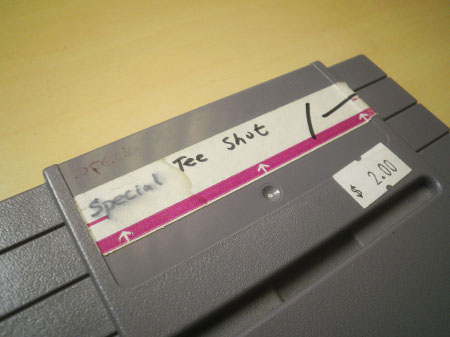 | 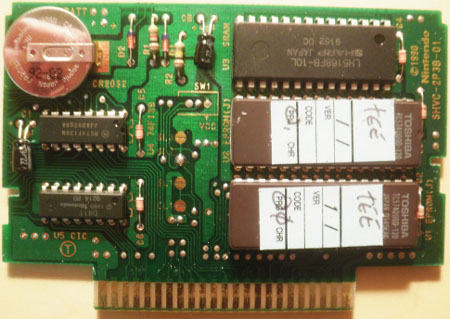 |
| Prototype cart (click here for original image) | PCB (click here for original image) |
Despite all that, the game's North American release was quietly moved off the board. Given the extent of prerelease preparations, Special Tee Shot's apparent cancellation was surprising, and while never positioned as a tentpole blockbuster, it's doubtful NoA would suddenly shelve a near-finished, pseudo-first-party project without good reason. That reason, of course, was Kirby.
The immediate warm response to Hoshi No Kirby (Kirby's Dream Land) in 1992 surely gave Nintendo & HAL pause for thought. Special Tee Shot was only one good sprint away from making it out the door, but the potential to retheme the game to take advantage of Kirby's blowing-up popularity may have been too great to ignore; HAL were, after all, hungry for a 16-bit hit. [Read more on that over at Retronauts.]
Video of the 1992 Summer CES, Skip to 2:53 for a view of Special Tee Shot from the CES show floor
By the end of 1993, HAL would already have its inaugural off-genre Kirby diversion wrapped and ready for the Japanese market. Kirby no Pinball (Kirby's Pinball Land), a game owing a great deal to HAL's earlier and immensely enjoyable Pinball: 66-hiki no Wani Daikoushin (Revenge of the 'Gator), shows a studio keen to repurpose and build upon its preexisting works, now with Kirby & crew mixed on top.
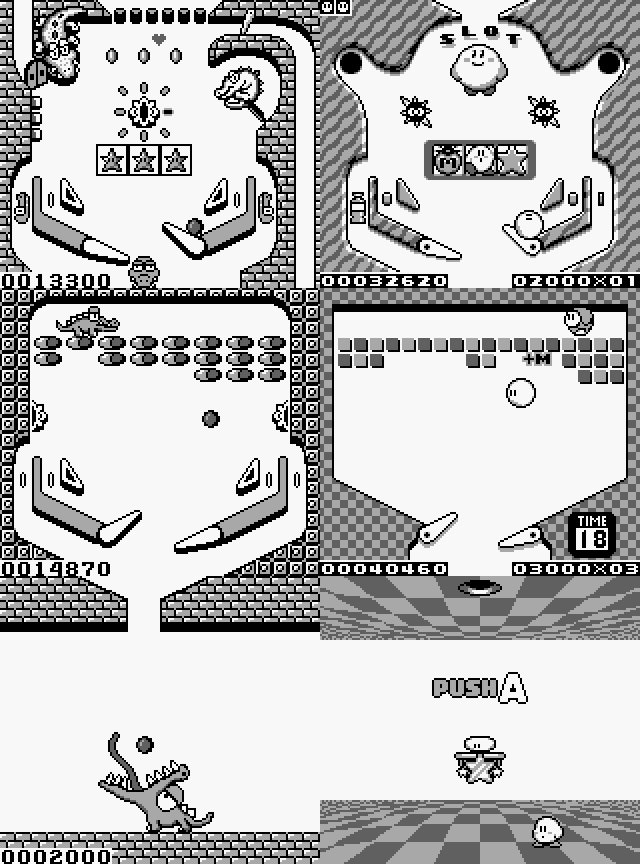 |
| Revenge of the ‘Gator vs. Kirby’s Pinball Land. HAL's pinball works on Game Boy show many striking similarities |
On cue, an oddly familiar mini golf project bearing the working title Kirby's Tee Shot began appearing in print previews. The paint was dry by the latter half of 1994 and Kirby Bowl (Kirby’s Dream Course) entered the picture, marking the franchise's fourth entry in well under two years. Far from getting lost in the rose-coloured shuffle, Kirby's Dream Course continues to get a lot of love in the modern day, with the best proof of that transformed title's enduring relevance being the SNES Classic inclusion of Kirby's trip to the Dream Land greens. On the other hand, Special Tee Shot remains largely anonymous, remembered as a means to an end in the greater Kirby chronicle and nothing more.
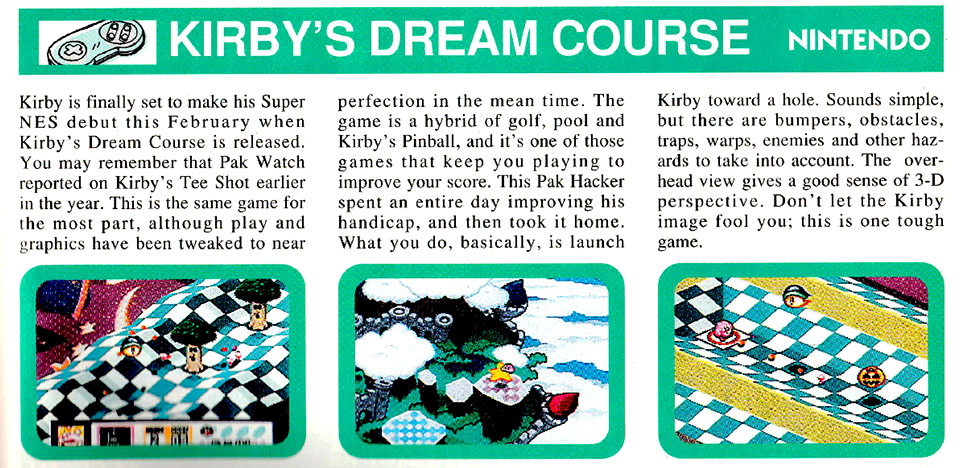 |
| scan of a Kirby’s Dream Course Pak Watch preview mentioning Kirby’s Tee Shot, From Nintendo Power Pak Watch (Vol. 47, December 1994) |
HAL’s metamorphic approach for rapid development of spin-offs paid off. Kirby’s Pinball Land would be certified a Player’s Choice million seller during the life of the Game Boy, and Kirby’s Dream Course found a wide and loving audience that Special Tee Shot would likely have struggled to match. During HAL’s initial explorations of the N64, work had even begun on the 4-player Kirby Bowl 64, a project that saw a dramatic about-face of its own once a novel airboarding element stole the momentum and floated away... only to return in the next console generation as Kirby Air Ride.
Some of the only available footage of Kirby Bowl 64 in action
Its successful rebirth as a Kirby spin-off doesn't mean Special Tee Shot is simply an empty vessel awaiting a pink-hued transfusion. Despite years in limbo, Special Tee Shot did make it to market on its own (in a non-physical Satellaview capacity), offering some small acknowledgement the makers were confident in their original vision's worthiness at last. This takes on significance because Special Tee Shot represents HAL's swan song in a long lineage of video golf, arguably existing within that history as a crowning achievement.
 |  |
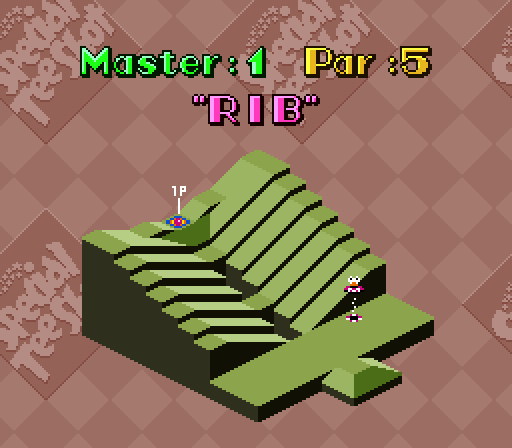 |
| A few select screenshots of the Special Tee Shot prototype |
While each of HAL's previous golf efforts sought to achieve increasingly realistic simulations of the sport, Special Tee Shot departs from that tradition by putting a cartoony and considerably more accessible spin on the company's highly developed golfing framework. Nintendo & HAL did away with many of the rigours and convolutions of conventional golf, choosing instead to innovate the time-tested formula with fun front and center. Holes are often wild in design and filled with imaginative hazards, toys and power-ups.
Its unassuming presentation makes it easy to overlook that in Special Tee Shot, HAL had developed a complex and fully navigable 3D environment with sophisticated 3D ball physics to match. To better appreciate what led to Special Tee Shot's understated technical achievements, we’ll start at HAL's origins and have a browse of the company’s balls-out gameography.
Going way back to the early '80s, HAL entered the scene as a game developer whose relationship with Commodore Japan would see an opening salvo of ports, clones and oddities hit the VIC-20 and C64. The company's focus then shifted to the Japanese home computer market, and it was here that HAL began to demonstrate a serious knack for skillful implementations of ball physics. This is likely attributable to a core team of adept programmers, including none other than former Commodore intern and future Nintendo President & CEO Satoru Iwata (well respected for coming to the Big N’s emergency aid with uncredited contributions to black box Pinball, Golf and Balloon Fight).
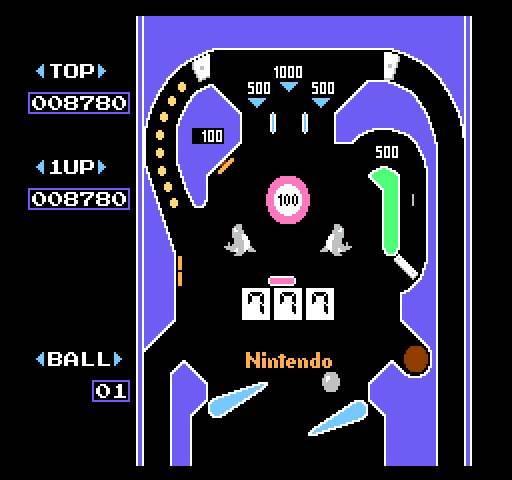 |  |
| NES Pinball | NES Golf |
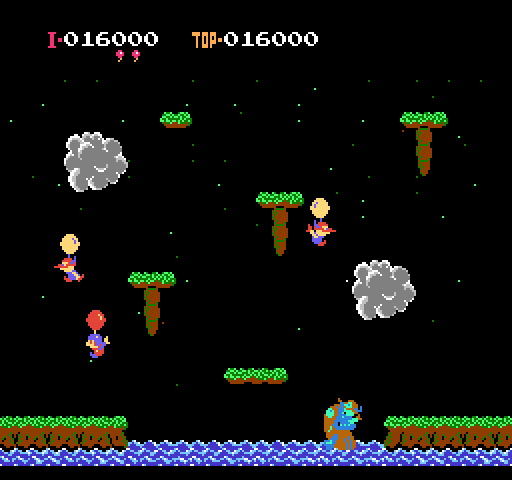 |
| Balloon Fight - Black boxes, blacker backgrounds |
Records of who worked on what in the '80s Japanese games industry are often fuzzy, owing to workplace cultures that frequently omitted credits altogether or favoured the use of staff pseudonyms. That being said, the aforementioned core team of programmers, in whole or in part, contributed to each of HAL’s ball-centric projects for which credits are available. The earliest of these is 1983's Super Billiards for MSX, the first project where eventual Kirby’s Dream Course / Special Tee Shot alumnists Satoru Iwata and Makoto Kanai would both work.
Shortly after, Nintendo's Golf for Famicom and HAL’s Hole in One for MSX saw release, and between this pair of 1984 contemporaries, the mould for video golf was being set. Even to this day, the 1-2 timing for shot strength and curvature as firmly established in both these trailblazing titles remains the genre's go-to control scheme. It comes as no surprise, then, that the shot controls of Hole in One and its MSX expansions - where credits reveal a team of F. Nakamura and S. Iwata - clearly resemble those in the later Special Tee Shot.
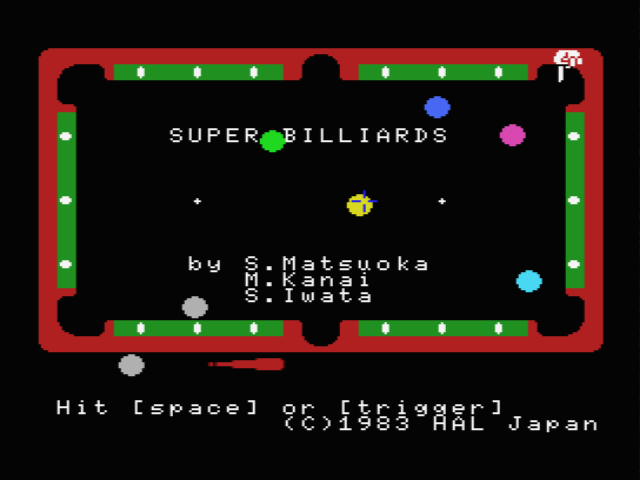 |
| Tile screen of Super Billiards - Title screen credits in the MSX era |
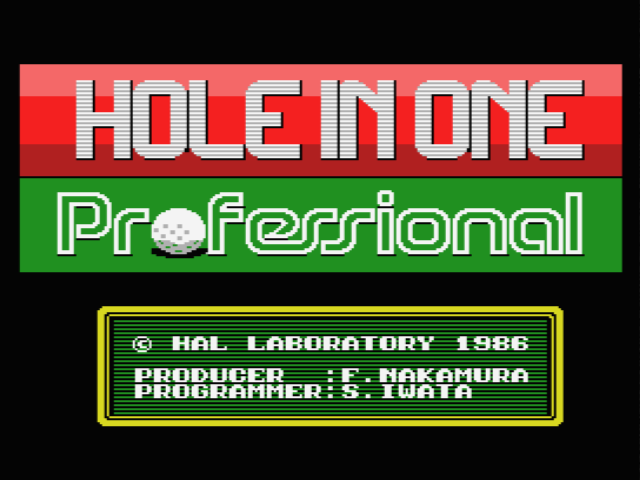 |
| Tile screen of Hole In One Professional - Title screen credits in the MSX era |
Compared to the discreet collaboration on black box Golf, Nintendo & HAL would cross clubs in a far less clandestine fashion for 1987's Famicom Disk System golfing double feature. Famicom Golf: Japan Course and Famicom Golf: US Course once more had Satoru Iwata and Makoto Kanai sharing the programmer's chair. Nintendo & HAL would team again for 1991's Mario Open Golf (NES Open Tournament Golf), with Iwata this time in the role of chief programmer while Kanai was overseeing production of (wait for it) Kirby's Dream Land.
In that same year, HAL would break ground on Nintendo's 16-bit hardware with 1991's Jumbo Ozaki no Hole In One (HAL's Hole in One Golf). It was the company's most realistic golf sim by a 500 yard drive, but threadbare credits leave the staff a mystery apart from the audio team (where Kirby composer extraordinaire Jun Ishikawa played a part). Despite no explicit mention, it seems reasonable to assume Makoto Kanai or Satoru Iwata were at least consulted for the project, if not directly involved.
 | 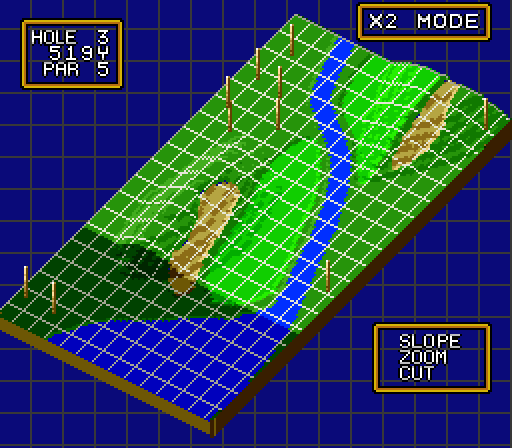 |
| HAL’s Hole in One Golf | HAL’s Hole in One Golf |
 |
| HAL golf simming in 16-bits |
And now, we've gotten caught up to Special Tee Shot. With the previous decade full of genre-refining golf titles and the experienced staff that helped make it happen, HAL & Nintendo EAD took a chance on a different kind of golfing game. Eschewing the arms race of sporting realism, Special Tee Shot's creative take on the sport and playful physics afford the game an ageless, pickupable quality not found in its most cumbersome and by-the-numbers peers. That Shigeru Miyamoto himself signed off on Special Tee Shot is worth considering, and the Rube Goldberg machinations of its more elaborate courses evoke the kind of childlike wonder expected from his touch.
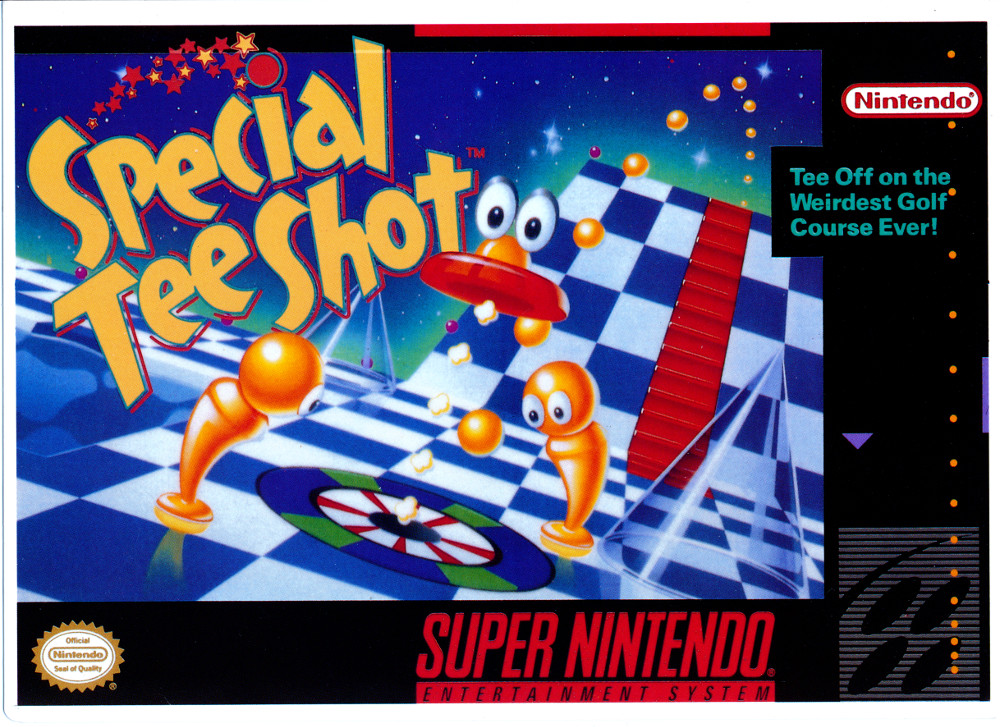 |
 |
| Special Tee Shot VidPro scans kindly provided by Matthew Callis |
The one missing piece is a well-defined and memorable theme, but for everything Kirby's Dream Course added by way of charm and personality, the conventions of golf became increasingly mutated. It’s the more traditional depiction of mini golf, in so far as the cup exists from the first stroke, scoring looks to each hole’s stated par and aiming requires higher precision, that makes Special Tee Shot very much its own game. A similar distinction could nearly be made of the more casual 1992 prototype and the hardcore 1996 Satellaview versions for all that’s different between them. [A detailed side-by-side of Special Tee Shot's prototype can be found in the original article, which is below.]
At present, the 1992 prototype is the closest thing we have to what Special Tee Shot would resemble had it shipped in North America on schedule. The handful of rough edges and bugs present in the prototype are by no means impediments to enjoying the game, and it's easy to imagine Special Tee Shot in the early SNES lineup. There's a certain curiosity fulfilled in playing the specific prerelease version of a game featured in a blurry promotional screenshot or captured via camcorder from an industry trade show; in some grander, needlessly romantic sense, it’s a living snapshot of an alternate gaming history.
Whatever the vintage, be it '92 prototype or '96 Satellaview, HAL's Kirby-less mini golf is worth taking a swing at.
Enormous gratitude to the following people:
- marvelus10 for kindly receiving the prototype and dumping the ROM
- Revenant (@notrevenant) for ripping the SPC set and digging into the game code
- LuigiBlood (@LuigiBlood) tagging the SPC set, preparing the "night" versions of select tracks, digging into the game code and trimming/header fixing the dumped ROM
- Matthew Callis (@superfamicom + eludevisibility.org) for securing and scanning the Special Tee Shot VidPro card featured in this article
ROM Image
The prototype ROM image, including one with a fixed header so that it can work on flash carts can be downloaded here. Luigiblood has also created a quality of life patch for the game, which, among other things, fixes the controls to make the game easier to play. Revenant has also posted complete SPC sets of the soundtrack of the game.
Original Article
This article was made prior to the dumping of the prototype game, and posted on February 17, 2017. I am keeping this up since it has a detailed comparison with the Satellaview release
Special Tee Shot is a game that was featured in Nintendo Power during the early stages of the release of the SNES, but completely fell off the radar. There is a good reason for this - the game was eventually remade using Kirby. It was evidently fairly close to completion, and a prototype made it out there. Special Tee Shot was previewed in the June 1992 issue of Nintendo Power, and even made it onto the back of the box of Super Nintendo systems.
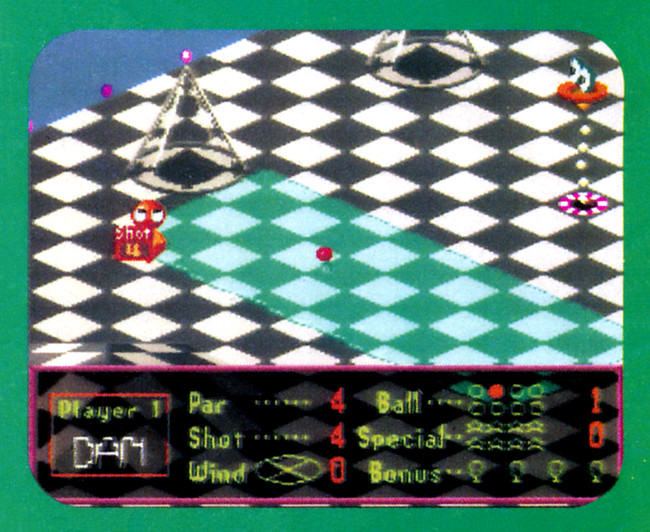 |
| Screenshot of Special Tee Shot in the June 1992 issue of Nintendo Power (page 112). Note that the menu is a lot different than the prototype or the Satellaview versions. Thanks to Frank Cifaldi for scanning this for me. |
Although Special Tee Shot eventually became Kirby's Dream Course, the gameplay differs in a fundamental way, at least in the Satellaview version that is available for playing. In Kirby's Dream Course, in order for the hole to appear, it is necessary to kill several enemies that lay around the course. Special Tee Shot is a more straightforward golf-style game where you merely need to get into the hole with as few shots as possible. The graphical style is pretty much the same, though. Another big difference is that in Kirby's Dream Course, you can aim the curve of your shot, while in Special Tee Shot, you can only to use the timed cursor to curve the ball. This, along with how fast cursor moves, makes Special Tee Shot a much more difficult game.
jbholio, who was once a prominent collector of oddities such as unlicensed games, purchased a prototype of Special Tee Shot on Ebay back in 2004. There is a thread about it on Digital Press. It sounds like it was a pretty epic auction that included a Super Starfox Weekend cart as well. He posted an extensive comparison of the prototype and the Satellaview versions of the game, however the website is long gone (though saved on archive.org). Years ago, he emailed me to say I could use whatever I wanted from his page, and since it doesn't exist anymore, I'm mirroring the information, along with some spruced up screen captures. Everything below was written by jbholio!
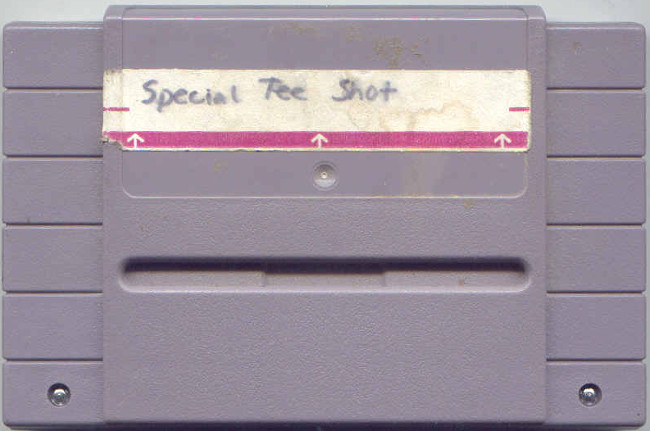 |
| Prototype cart |
------------------------
Kirby's Dream Course used to be known as Special Tee Shot in it's earlier stage of development but both games are more or less the same. The control of the games are similar but in Kirby's Dream Course, you have to kill the enemies before the hole appears. Special Tee Shot is more like a mini golf game, you only have to put the little red ball in the hole. The game was never released as Special Tee Shot but I don't know why because it is one of the best SNES games I've played. It was also never released on cartridge but only on a system to be used with the Super Famicom called the Broadcast Satellaview X (BS-X). This may be the only copy in existence!
Some direct comparisons between the prototype and the Satellaview version. Note that the prototype screenshots were taken with a camera.
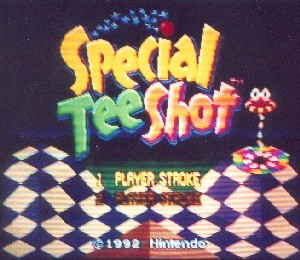 | 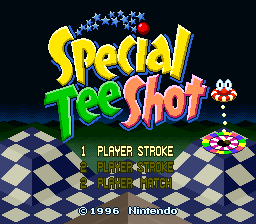 |
| Prototype - ©1992 Nintendo No "2 Player Match" option | Satellaview - ©1996 Nintendo |
 | 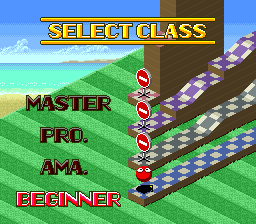 |
| Prototype | Satellaview |
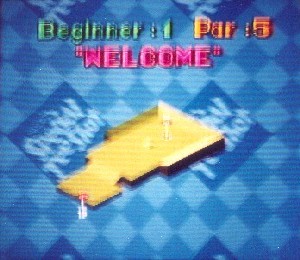 | 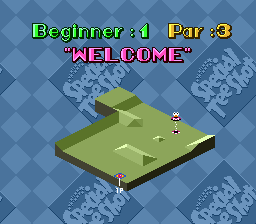 |
| Prototype | Satellaview |
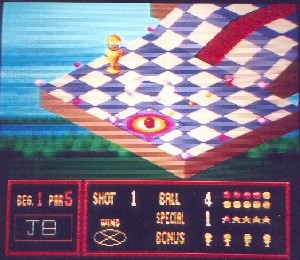 | 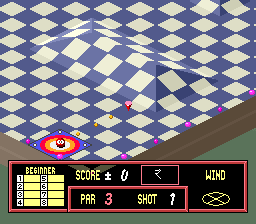 |
| Prototype - The bottom of the screen is different. | Satellaview |
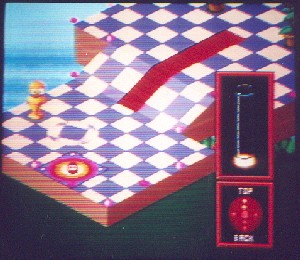 | 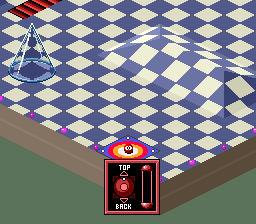 |
| Prototype - BIG Spin/Power Meter | Satellaview |
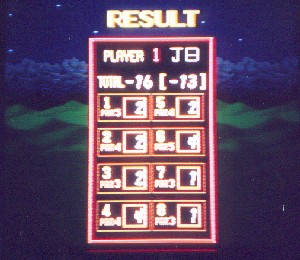 | 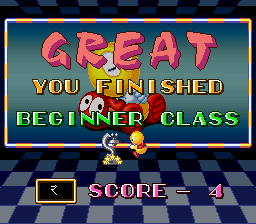 |
| Prototype | Satellaview |
 | 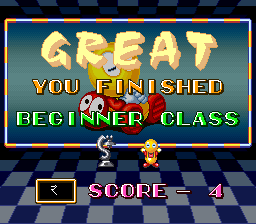 |
| Prototype | Satellaview |
Controls
There are some differences in the controls between the prototype and the Satallaview versions of the game.
Prototype
- Y = see angle, direction and wind • show spot of landing (pink cone
 ) • cancel start of Spin/Power meter.
) • cancel start of Spin/Power meter. - B = look at course.
- A = start and stop Spin/Power meter.
- X = show current hole and result.
- Select = nothing.
- Start = show bottom part of the screen • select type of shot (normal or special).
- Up = change distance of shot.
- Left/Right = change direction of ball.
- Down = shoot ball in the air • change distance of shot.
- L,R = nothing.
Satellaview
- Y = look at the course • cancel start of Spin/Power meter.
- B = look at the course • cancel start of Spin/Power meter.
- A = start and stop Spin/Power meter.
- X = look at the course • cancel start of Spin/Power meter.
- Select = show result.
- Start = show current hole.
- Up = change distance of shot • see farther the direction of the ball when putting.
- Left/Right = change direction of ball • change spin of ball.
- Down = shoot ball in the air • change distance of shot • show spot of landing and bouncing (pink cones ).
- L,R = nothing.
Total Members
There can be 10 different members in the prototype, while the Satellaview version allows only 5.
Starting a New Class
 fly across the screen to give 5 balls, see picture below. The Satellaview does not do this.
fly across the screen to give 5 balls, see picture below. The Satellaview does not do this.
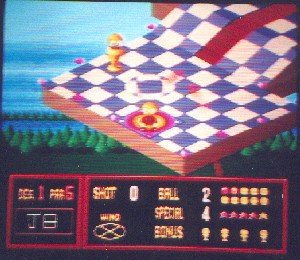 |
Total Balls
Prototype: You start hole #1 of every class with 5 balls. Before each hole (except hole #1) you are given extra balls. If the hole is a Par 3 you will receive 3 extra balls, Par 4 = 4 extra balls and so on. You don't lose balls when you putt the ball O.B., however you do lose a stroke. When you are out of balls ...GameOver. 
Satellaview: Every hole you have 10 shots to putt the ball in the cup or you are Game Over.
Before Each Shot...
Prototype: ...  fly across the screen with the number of the current shot in his hands (see picture below). If the number is more than 9, it says X instead of a number.
fly across the screen with the number of the current shot in his hands (see picture below). If the number is more than 9, it says X instead of a number.
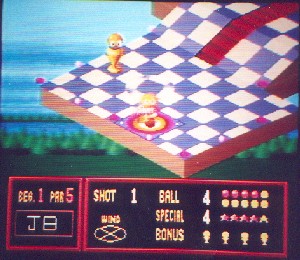 |
Satellaview: ... the ball transform into a number 


 or
or 
Landing and Bouncing
Prototype:You have to press Y if you want to see where the ball will land. You cannot see where it will bounce. Also, when pressing Y the angle of the shot, the direction of the ball and the wind are shown on the screen (see picture below). Wind also shown on the bottom of the screen in the middle.
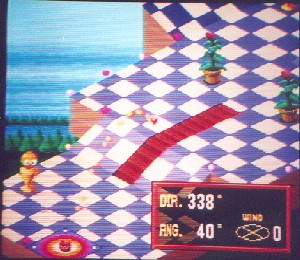 |
Satellaview: You see where the ball lands and bounces just by pushing down on the control pad. There is no angle or direction anywhere in the game. The wind is shown on the bottom right of the screen.
Blobs of Water 
Prototype: The ball bounces on the blob.
Satellaview: The blob sucks the ball in and make you lose a stroke.
Power Shots
Prototype: No Power Shots.
Satellaview: One power shot is received every time you hit  but you must use it as your next stroke.
but you must use it as your next stroke.
Special Shots
Prototype: When starting a new class you are given 1 to 5 special shots which can be used at any time. The higher is your level the more shots you start with. You also receive one more every time you hit a flashing yellow tile.
Satellaview: One special shot is received every time you hit  but you must use it as your next stroke.
but you must use it as your next stroke.
Bonus Room
Prototype: There is a bonus room when you collect 4  and putt the ball in a special cup.
and putt the ball in a special cup.  While in the bonus room, you have 60 seconds to hit 4
While in the bonus room, you have 60 seconds to hit 4  grey and putt the ball in the cup (see picture below). If you succeed your score will be -6 (see picture below). There are 4 different bonus rooms.
grey and putt the ball in the cup (see picture below). If you succeed your score will be -6 (see picture below). There are 4 different bonus rooms.
Satellaview: No Bonus Room.
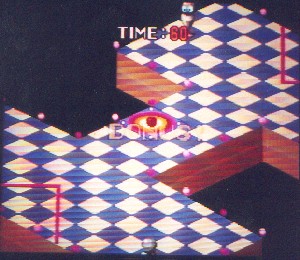 | 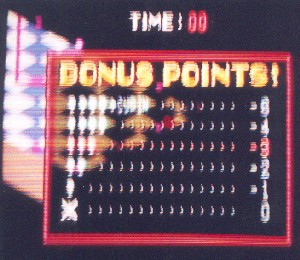 |
| putt the ball in the cup | If you succeed your score will be -6 |
Putting the Ball in the Cup
Prototype: If you are 3 under Par there are letters that come out of the hole spelling "Nice Albatross!!". 2 under Par = "Nice Eagle!!", 1 under Par = "Nice Birdie!!" or Par = "Nice Par!!". Nothing if over Par. Then  comes over the cup with the total number of shots in his hands.
comes over the cup with the total number of shots in his hands.
Satellaview:  flies on the top of the cup with the score => ...
flies on the top of the cup with the score => ... 

 ...
...
Result Board (see pictures above)
Prototype: No star to indicate a hole in one. Total shots for each hole and score are shown. The score is separated in two parts : the first number is the actual score including bonus points (-16) and the other is the actual score (-13). 
Satellaview: A star with a "1" inside appears next to every hole in one. Only total score is shown (-14).
Trophy
Prototype: There seem to have a bug because even if you win the Gold trophy in a class you will often have a Bronze trophy when you look at your stats. There is no Silver trophy (I think).
Satellaview: Gold, Silver and Bronze trophies available. No trophy bug.
Demo
Prototype: A demo of a hole starts by not pressing anything on the control pad while on the title screen. The hole is named Extra4 #1 but it is not in the BS-X version. (see screenshot below)
Satellaview: No demo. The game resets if you don't press anything on the title screen.
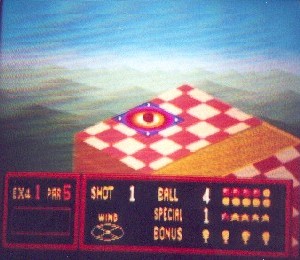 |
Holes
All holes between the 2 versions are differents. Some are similar but none are exactly the same (most are tougher in the proto version). I don't think there are holes Extra 1,2,3,4 in the proto but I could be wrong because of the demo hole.
| Hole # | - Beginner Class - | |
|
PROTO |
Satellaview |
|
| 1 | Welcome (not the same as BS Beginner #1) | Welcome (not the same as proto Beginner #1) |
| 2 | Water Hole | Toss Up |
| 3 | Steps | Water Park |
| 4 | Gap (similar to BS Beginner #7) | Conveyor Belt |
| 5 | Big Wave (similar to BS Beginner #6) | Dance Floor |
| 6 | Steps 2 (similar to BS Extra2 #3) | Big Wave (similar to proto Beginner #5) |
| 7 | Twin Peak | Hop Step (similar to proto Beginner #4) |
| 8 | Air Curtain (similar to BS Extra 1 #7) | Over The Sea |
| Hole # | - Amateur Class - | |
|
PROTO |
Satellaview |
|
| 1 | Blue Lake (similar to BS Amateur #1) | Pier (similar to proto Amateur #1) |
| 2 | Space Ship (more or less similar to BS Pro #1) (not same as Extra2 #7) | Tower (similar to proto Amateur #4) |
| 3 | Launcher | Rubbish Chute |
| 4 | Tower (similar to BS Amateur #2) | Marsh |
| 5 | Spoon (similar to BS Amateur #7) | Kickturn |
| 6 | Water Square (similar to BS Amateur #6) | Hoof (similar to proto Amateur #6) |
| 7 | Stadium | Spoon (similar to proto Amateur #5) |
| 8 | Hill Climb (similar to BS Pro #8) | Anchor |
| Hole # | - Pro Class - | |
|
PROTO |
Satellaview |
|
| 1 | Cliff (more or less similar to BS Extra 3 #5) | Bridge (more or less similar to proto Amateur #2) |
| 2 | Big Slider (similar to BS Pro #3) | Shoot |
| 3 | Double Jump (similar to BS Master #3) | Big Slider (similar to proto Pro #2) |
| 4 | Down Hill (similar to BS Pro #7) | Candy |
| 5 | Splash | The Alps |
| 6 | V Turn (similar to BS Extra 2 #1) | Glass Shoot |
| 7 | Butterfly | Down Hill (similar to proto Pro #4) |
| 8 | Hurdle | Hill Climb (similar to proto Amateur #8) |
| Hole # | - Master Class - | |
|
PROTO |
Satellaview |
|
| 1 | Rib (similar to BS Extra 3 #1) | Hammer Head (similar to proto Master #4) |
| 2 | Twin Bridges (similar to BS Extra4 #1) | Good Luck |
| 3 | Crevasse | Double Jump (similar to proto Pro #3) |
| 4 | Hammer Head (similar to BS Master #1) | Tank Head |
| 5 | Up Down | Do Not Fall |
| 6 | Tower 2 (similar to BS Extra2 #2) | Island Chain |
| 7 | Gun Shot (similar to BS Extra1 #1) | Top Spin |
| 8 | Narrow Bridge | Leap Up |
| Hole # | - Extra 1 - | |
|
PROTO |
Satellaview |
|
| 1 | N/A | Try To Air (similar to proto Master #7) |
| 2 | N/A | Cheap Trick |
| 3 | N/A | Tier Stand |
| 4 | N/A | Little Pond |
| 5 | N/A | High Jump |
| 6 | N/A | Catapult |
| 7 | N/A | Dance On Air (similar to proto Beginner #8) |
| 8 | N/A | Landslide |
| Hole # | - Extra 2 - | |
|
PROTO |
Satellaview |
|
| 1 | N/A | Lightning (similar to proto Pro #6) |
| 2 | N/A | Twin Towers (similar to proto Master #6) |
| 3 | N/A | Triple Jump (similar to proto Beginner #6) |
| 4 | N/A | Downstairs |
| 5 | N/A | Reflex |
| 6 | N/A | Narrow Road |
| 7 | N/A | Space Ship (not the same as proto Amateur #2) |
| 8 | N/A | Big X |
| Hole # | - Extra 3 - | |
|
PROTO |
Satellaview |
|
| 1 | N/A | Rib (similar to proto Master #1) |
| 2 | N/A | Rattlesnake |
| 3 | N/A | Big Bridge |
| 4 | N/A | Shining Alley |
| 5 | N/A | Cliff (more or less similar to proto Pro #1) |
| 6 | N/A | Twisted Way |
| 7 | N/A | Challenger |
| 8 | N/A | Railgun |
| Hole # | - Extra 4 - | |
|
PROTO |
Satellaview |
|
| 1 | N/A | Two Bridges (similar to proto Master #2) |
| 2 | N/A | Strike Square |
| 3 | N/A | Spinning |
| 4 | N/A | Trick Shot |
| 5 | N/A | Mt Fuji |
| 6 | N/A | Wonder Corn |
| 7 | N/A | Great Wall |
| 8 | N/A | Great Mountain |
| Review of Special Tee Shot | ||
|
Prototype |
Satellaview |
|
| Graphics | 8.5/10 | 8.5/10 |
| Music/Sound | 9.5/10 | 9.5/10 |
| Control | 8.5/10 | 8.5/10 |
| Replay Value | 8/10 | 8.5/10 |
| Fun | 10/10 | 10/10 |
| Overall | 8.9/10 | 9/10 |
AD from a Super Nintendo System Box
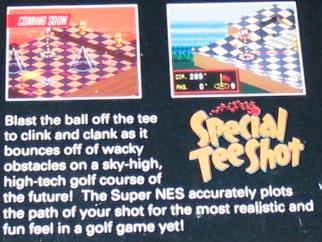 |
| Thanks to v1rich for the pic |
The screenshot on the left is very similar to Beginner hole #6 (Steps 2). The only difference is the platform on the upper right side of the hole (with the two  ). In the proto it's on the upper left side of the hole.
). In the proto it's on the upper left side of the hole.
The screenshot on the right is Beginner hole #3 (Steps).
The screenshots are from the prototype because I played the Satellaview version and they are not anywhere in the game.